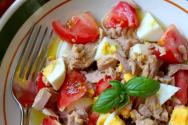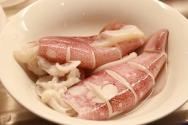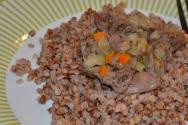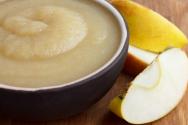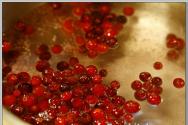What drinks are served with fish? Serving wines. Optimal wine temperature
Traditional rules say that white wine must be paired with white meat, red wine with red meat - and there is no third option. But at the same time, steaks, cutlets and salmon fillets have a pronounced pink color. In this case, what wine is best to pair with this fish? Pink? It makes sense, but in fact the popularity and variety of forms in which salmon is served ensures that it pairs well with both rosé and white or red wines.
However, when pairing salmon with wine, it is important to consider the sauce and spices with which this fatty fish is served. The pairing of salmon with a particular wine depends on the flavor of the spices, the overall texture of the dish and the style of its preparation, and not just on the fish itself.
Salmon with rose wine
Rose wine is considered the standard choice for any salmon dish, thanks to its rich red fruit flavors, pronounced acidity and dry, mineral finish. These qualities make rosé very flexible when pairing with salmon. Moreover, rosé wine combines the qualities and strengths that red and white wine gain when paired with salmon. A pink champagne Not only will it add elegance to the salmon, but it will also allow spices and seasonings to more clearly express their taste against the background of fatty and rich fish due to the high level of acidity of the wine.
Notes of red fruits and a pleasant acidity of rose wine will reveal new facets of smoked salmon with crème fraiche, boiled salmon or French salmon pate and will satisfy the taste preferences of many gourmets.
Salmon with red wine
Without a doubt, the best wine to pair with salmon is pinot noir. The soft tannin structure, strawberry and raspberry flavors, and earthy notes of pinot noir will bring out the full flavor of salmon baked in herbs or smoked with cedar chips. Granache or zinfandel Goes great with grilled or seared salmon. And with regular baked salmon, it is best enjoyed in the company of a glass Spanish Mencia.
Salmon with white wine
A fairly wide range of white wines goes well with salmon and the spices and sauces often used in its preparation. If your salmon is sprinkled with dill or has pronounced citrus notes, then herbaceousness, citrusiness and minerality form a good tandem with it. Sauvignon Blanc. If the taste of fish is emphasized by creamy sauce, then preference should be given chardonnay, aged in oak or the depth and freshness of Loire Sancerre.
Chardonnay, white Burgundy And Sancerre will highlight the rich oiliness of salmon and emphasize its weakly expressed shades. Semi-dry German Riesling goes better with pate and salmon sushi. Lighter wines with floral aroma and apple flavor - like pinot gris from Oregon or Alsace - pair amazingly with almost any salmon dish. And marinades based on ginger, brown sugar or maple syrup with a hint of garlic are combined with Gewürztraminer(a semi-dry white wine with exotic notes), like yin and yang.
The harmonious union of fish and wine is famous for its exquisite flavor shades. The immutable rule is: white wine goes best with fish. However, enlightened chefs will be happy to tell you that a glass of red wine can make a worthy pair for a fish dish.
Developing a sense of taste
The logic of the well-known combination of white wine and fish is explained by the not entirely harmonious nature of the latter. The fact is that most varieties are high in salt, which does not interact well with the tannins of red wine. In addition, nature has endowed the fish with a delicate taste. And if you combine it with rich red wines, not a trace of tenderness will remain. But white wines, on the contrary, are capable of not only preserving the finest harmony of flavors, but also emphasizing subtle nuances. White wine is favored by light sourness and effervescence, which best balance out too fatty fish varieties. To make a good choice, you need to listen to your own feelings. The duration of the aftertaste of the dish should correspond to the duration of the aftertaste of the wine.
However, there are exceptions to every rule, and among red wines you can also find a harmonious addition to fish dishes. This trend took hold not so long ago and appealed to many gourmets with a craving for original novelty. Therefore, today in restaurants you can often see a combination of grilled salmon or sea trout with a glass of red wine. Fans of fusion-style experiments even manage to combine red wine and seafood sushi. Be that as it may, one rule remains the same for any combination: the nobler the type of fish, the more elite the wine should be.
What kind of wine does fish like?

The fish itself is ready to suggest a few simple rules that will help you choose a decent drink to go with it. For delicate varieties of fish - light wine. Conversely, saturated fatty varieties produce thick, complex wines. In other words, the fish should not dominate, and the wine should not overwhelm the taste of the dish.
The method of preparation also plays an important role. Raw fish is ideal for young wines with sharp acidity. For a more intricate tandem, you can take champagne or some sparkling wine. Do you prefer healthy food? Then you should choose light wines from the Loire to pair with steamed fish. Smoked fish loves a complex combination of rich acidity and at the same time sweet notes. These requirements are fully met by Gewürztraminer, Riesling or Pinot Gris wines. Aged wines with a bright fruity bouquet, such as Sauvignon Blanc or Chablis, will successfully complement the smoky taste. But fried or grilled fish allows both white varieties, rosé and even light red wines, like Pinot Noir. The classic Russian appetizer in the form of herring goes well not only with vodka, but also with dry Fino sherry.
If you plan to prepare a complex dish, such as a casserole or a hearty fish pie, it is best to complement them with young wines with intense flavors. White Californian Sauvignon or pink Austrian Schilcher will go equally well with such dishes. Red varieties, for example, Blauer Zweigelt or Bourgogne Rouge, would also be appropriate here. The main thing is that the wine should not be too strong.
Choosing the right drink can make all the difference to the sauce. Thus, fish with cream sauce will fully open up under the influence of white Burgundy wine, which has a complex structure and rich bouquet. Fish with red sauce is just the case when you can safely uncork a bottle of red wine. However, in this case, the choice should be made on varieties that are not too tart and have a low tannin content. Pinot Noir or wines from the Graves region will be a good solution. Another win-win option would be dry rose wines - Californian Zinfandel or Spanish Tempranillo. Fish with garlic sauce or complex spicy seasonings will sparkle with all its flavor facets if you add wines with berry tones to it - Riesling, Pinot Grigio or Traminer.
What to combine seafood with

Only seafood can compete with fish in sophistication, especially if you choose the right wine to go with it. Perhaps the most famous combination is oysters and champagne. However, this union cannot be called successful. The reason for this is oyster juice, which interrupts the subtlest flavor nuances of champagne, and, moreover, is absolutely not in harmony with the sweet aftertaste of brut. The choice of wine for oysters should take into account their origin. Thus, dry white Muscadet wine is best suited for French oysters, and New Zealand Sauvignon Blanc is best for Dutch oysters.
For laconic appetizers of shrimp and mussels, you can choose white table wine. Shellfish will reveal all their flavor subtleties if the glass contains wine with a rich, deep taste and nutty notes.
Lobsters, lobsters or spiny lobsters are exceptionally noble delicacies, so they require an addition to match. At the same time, choosing a suitable pair for crustaceans is much easier than dealing with them, observing all the rules of etiquette. Chardonnay goes best with their tender sweet meat. At the same time, its color and where it came from are absolutely unimportant: from France, Australia or America.
Creating time-tested harmonious combinations is just as interesting as experimenting with new flavor combinations. We wish you inspiration, successful discoveries and, of course, bon appetit.
It’s not easy to choose a wine to pair with fish. It is usually served with white wines. But there are a lot of types of wine and types of fish. How can you do this to combine them with each other? Often fish is not served on its own, but with various sauces, with which the wine should also be in harmony. There are certain rules for pairing wines with certain types of seafood. The rest is a matter of experimentation.
1. Champagne and Italian sparkling wines.
Sparkling wines, whether produced in California, France, Spain or Italy, are ideal for fried foods. Light beers also go well with the same food. If you take ordinary wines, the taste of fried fish often overwhelms them, which cannot be said about sparkling wines, the bubbles of which break through the taste of fish and complement it deliciously. If you don't like sparkling wine, try the Portuguese Vinho Verde.
2. Chenin Blanc, Sauvignon Blanc, Pinot Grigio.
These wines go best with white fish. They are dry, austere and have a distinct taste. Chenin Blanc and Pinot Grigio go well with white fish prepared in the simplest ways. They are good served with flounder, halibut, pike perch, fresh clams and oysters. They go well with the taste of striped bass, catfish, lobster, shrimp and mussels. If these wines are not enough for you, you can try Italian Vermentino and Greek Assyrtiko with white fish.
3. Chardonnay, Fume Blanc, Viognier, Pinot Gris.
Chardonnay aged in oak barrels goes perfectly with striped bass, crab, fresh oysters and lobster. This full-bodied wine pairs very well with a richly flavored dish. Chardonnay also goes great with crab soup. But for fattier fish, such as mackerel or bluefish, or is better suited.
4. Marsanne, Gewürztraminer, Roussanne and Riesling.
These wines, which have somewhat tropical flavors, go well with Asian seafood or spicy fish.
5. Albariño, Verdelho.
These wine varieties come from Spain and, although they are now also produced in the USA. They are incredible with clams, mussels, scallops, crab and lobster.
6. Dry Sherry Fino.
This wine is perfect with simple boiled shrimp. However, it also goes well with fried, steamed and grilled shrimp. It is important that it be real Spanish. It is very dry and even seems a little salty. You can serve almonds with this wine.
7. , Gamay, Sangiovese, Grenache.
These are all light red wines. Although red wine is rarely served with seafood, these wines go well with salmon, tuna, marlin, swordfish, mackerel, bluefish and other large, fatty fish. It is important not to serve red wine with spicy seafood, as it will give it an unpleasant metallic taste.
8. Rose wines.
They can be used in place of white Chardonnay and Blanc. They can be served with tuna, swordfish and seafood soups.
That's all the basic wine combinations with fish and seafood. But you can experiment. You may find some special delicious combinations that are not mentioned in this article.
The culture of wine consumption has evolved over centuries. Therefore, in order to truly experience the charm of this amazing drink, you must follow very specific rules that have stood the test of time.
In what order and what wines should be served?
Table traditions dictate a fairly strict order, in accordance with which different types of wine should be consumed.
Before meals, that is, practically on an empty stomach, they drink so-called aperitifs. In fact, their task is to whet the appetite of the guests to such an extent that any dishes then offered by the hostess seem to them the height of culinary art. Therefore, aperitifs are drunk in small quantities and always before everyone sits down at the table. They are usually offered to guests who wander aimlessly around the apartment waiting for late arrivals to brighten up a prolonged pause.
Flavored wines such as vermouth or martini are good as an aperitif. They are made from grapes with the addition of alcohol, sucrose, and infusions of various plants.
Table wines are served during the main meal. They are classified into white and red (depending on the grape variety from which they are made), and dry, semi-dry and semi-sweet (depending on the sugar content in them). Table wines are produced without the addition of alcohol, so they gain strength only through the fermentation of grape juice. The most famous varieties of white table wines are made from Chardonnay, Sauvignon, Riesling, and Muscat grapes. Among red table wines, wines made from grape varieties are very popular "Cabernet Sauvignon", Merlot, Pinot Noir.
Wines, which are called fortified, can also be used during the main meal., although not as widely as canteens. Some fortified wines are an excellent complement to both first and second courses. These include strong wines - Madeira, sherry, port. They differ from their fortified, but called dessert counterparts, by having a lower sugar content and a higher alcohol content.
At the end, it is customary to serve mainly fortified dessert wines., which in turn are divided into sweet and liqueur. This is dictated by their high sugar content, which can reach up to 33 percent.
Throughout the feast, wines containing carbon dioxide can traditionally be consumed. These are, first of all, various types of champagne and sparkling wines, which are saturated with carbon dioxide naturally, that is, as a result of secondary fermentation of the wine material. In addition, there are also sparkling or carbonated wines artificially saturated with carbon dioxide. All carbonated wines range from extra-dry to sweet. Depending on this, they accompany certain dishes.
What wine should I serve with what dish?
 There is a common belief that red wines should be served with beef, lamb or turkey, and white wines should be served with fish, vegetables, as well as pork and chicken. In fact, everything is much more complicated, and a lot depends on the taste of the dish - whether it is spicy or mild, spicy or sharp.
There is a common belief that red wines should be served with beef, lamb or turkey, and white wines should be served with fish, vegetables, as well as pork and chicken. In fact, everything is much more complicated, and a lot depends on the taste of the dish - whether it is spicy or mild, spicy or sharp.
Dry white wine goes well with a light appetizer of meat and fish.; For vegetable “prelude”, along with it, white semi-dry and semi-sweet wine is also recommended. The same accompaniment is required for seafood - shrimp, mussels or oysters.
Spicy salads and substantial meat snacks go well with strong wines with low sugar content, both white and red. It could be sherry, Madeira or port.
These same strong wines are served with broths and pureed soups.
Second courses of any fried meat (steaks, escalopes, entrecotes, languettes, natural breaded cutlets) are best washed down with dry red wine. In addition, it goes well with dishes made from liver, kidneys and brains - no matter whose, as well as classic shish kebab and pilaf.
Hot fish dishes (fried or steamed) are in harmony only with dry white wines, especially with soft riesling. But if the fish is cooked in a spicy or spicy sauce, then it should be served with dry wine with a sharper taste, including red. But offering red wine with canned fish is strictly contraindicated.
The taste of a dessert such as cake or ice cream is well emphasized by fortified dessert wines. Moreover, the dessert must be sweeter than the wine. But sometimes young dry wine can be served with moderately sweet fruit dishes, such as mousse or jelly. If it has pronounced fruity notes, it will most likely play in unison with the dessert. Remember one rule: before serving coffee, all wine is removed from the table.
Dry and semi-dry champagne can be consumed with the same dishes - from appetizers to main dishes - as white table wine. But sweet champagne is served only for dessert. But we must remember that it is incompatible with chocolate and its derivatives, as well as with citrus fruits. But with any champagne, Roquefort or hard cheese served for dessert, as well as dry biscuits, nuts and all kinds of cakes (with the exception of chocolate) go well with any champagne.
How to properly cool wine?
In order for the taste of wine to fully manifest itself, it must have a very specific temperature when served.. Thus, it is customary to cool dry white wines in winter to 10 - 12 degrees, and in summer the temperature can be reduced to 8. Dry red wines are drunk warmer - from 16 to 20 degrees (the choice in this range also depends on the time of year). Fortified wines should be at the same temperature.
Champagne should be served chilled., so don’t forget to first put it in the refrigerator (but not in the freezer!) for three hours. It is not recommended to bury the bottle in the snow on the balcony. This does not guarantee the required degree of chilling, and over-chilled champagne becomes tasteless.
What glasses should you drink from?
 Whatever wine is served to the table, it should be drunk from transparent stemmed wine glasses made of thin colorless glass. This is the only way you can appreciate not only the taste, but also the color of this noble drink.
Whatever wine is served to the table, it should be drunk from transparent stemmed wine glasses made of thin colorless glass. This is the only way you can appreciate not only the taste, but also the color of this noble drink.
Wines with a simple bouquet are drunk from straight-sided wine glasses. But thin, high-quality wines are best drunk from glasses that taper slightly at the top. This allows you to enjoy the aroma of the wine longer. In any case, the container is only filled to half.
Flute or tulip shaped glasses are suitable for champagne.
What is the relationship between the price of wine and its quality?
 The price of wine is directly dependent on its quality. Ordinary wines are the cheapest. They are produced without any aging, but, however, not earlier than 3 months after the grapes are processed. Vintage wines are much more expensive than ordinary ones. These are high quality aged wines produced from the best grape varieties using special technology. Aging of vintage wines ranges from one and a half years for dry table wines and from two years for fortified wines. Collection wines are the elite of vintage wines, which, after the end of the aging period in barrels or tanks, are additionally aged for at least three years. At their dizzying price, which is comparable to the price of a limousine, they have no equal among wines.
The price of wine is directly dependent on its quality. Ordinary wines are the cheapest. They are produced without any aging, but, however, not earlier than 3 months after the grapes are processed. Vintage wines are much more expensive than ordinary ones. These are high quality aged wines produced from the best grape varieties using special technology. Aging of vintage wines ranges from one and a half years for dry table wines and from two years for fortified wines. Collection wines are the elite of vintage wines, which, after the end of the aging period in barrels or tanks, are additionally aged for at least three years. At their dizzying price, which is comparable to the price of a limousine, they have no equal among wines.
IT IS IMPORTANT TO KNOW:
According to gourmets, the taste of wine is irrevocably lost under the influence of tobacco smoke. It is no coincidence that restaurants have so-called cigar rooms, where visitors enjoy smoking after a meal. And if they drink alcohol there, it’s certainly not wine, but cognac or whiskey.
Rate this article
Many people are mistaken that fish is ideal only with white wine. Experienced chefs refute this truth and prove that a glass of red wine in combination with a fish dish can create a wonderful flavor combination. Everything in this case depends on the type of fish.
In the article:
Best wine for fish
The inhabitants of the seabed do not interact well with the tannin contained in red wine. The delicate taste of fish meat is lost when consumed with a red alcoholic drink. White wine, on the contrary, allows you to emphasize the delicate taste of fish products and emphasize the subtle characteristics of delicate meat.
An exception to this rule may be the majority, which go well with fish due to the small amount of tart tannins. That is why many elite restaurants often serve salmon or trout with a glass of red wine.
In order to achieve balance between food and aperitif, it is worth understanding that they must be combined with each other. Fish cannot drown out the taste of an alcoholic drink, and wine cannot dominate the dish.
The technology of preparing seafood also plays an important role:
- As a complement to raw fish meat, sour wine from young grapes, champagne or sparkling table wines are ideal;
- Steamed fish meat goes well with light wines.
- Smoked carcasses will form an ideal tandem with white and red wines of high acidity and a high degree of sweetness. For example, traditional Riesling or Pinot Gris, Sauvignon, Gewurtstraminer and others.
- Any wine is allowed with pan-fried or grilled fish, but it must be light. The gentle alcoholic drink balances out the heavy roasted texture of the meat.
- Herring is traditionally consumed with vodka, but dry wines also go well with such an appetizer.
- Dishes using seafood (pizza, casserole, fish pie and others) go well with wine products with a rich, pronounced taste. It is better to take white or rose young wines. For red varieties, we recommend Bourgogne or Blauer.
- Wines from Burgundy are distinguished by an abundance of aroma and taste, so they are perfect for serving with fish dishes using a creamy sauce.
- Red sauces with which fish is cooked and served encourage the consumption of a glass of red wine. It is better to choose varieties that have minimal tannin content, for example: Tempranillo or Pinot Noir.
- When preparing seafood using garlic or spices, you should uncork a bottle of an alcoholic drink that has berry tones in its taste. For example, the same Riesling.
Wine and oysters
 Any self-respecting catering establishment includes such an exquisite delicacy as oysters on its menu. It is generally accepted that champagne should be served with oysters, but in fact this is the worst decision. Oyster juice has a salty taste, and when combined with sweet sparkling there is an unpleasant aftertaste.
Any self-respecting catering establishment includes such an exquisite delicacy as oysters on its menu. It is generally accepted that champagne should be served with oysters, but in fact this is the worst decision. Oyster juice has a salty taste, and when combined with sweet sparkling there is an unpleasant aftertaste.
Therefore, dry white wines or light red wines are much better suited to such a delicacy. In particular, these are Sauvignon, Muscadet and others. In this case, it is worth considering the origin of seafood. The salinity of oyster juice varies depending on the habitat.
Crayfish, lobster, crab, lobster, shrimp and mussels
 It is worth choosing wine for these seafood products based on the cost and taste of the crustaceans. For example, it is better to serve expensive lobsters and lobsters classic Chardonnay. The region of manufacture is not of fundamental importance. The technology for preparing seafood in this case is also unimportant. Crustaceans are prepared by dipping into boiling water, grilling or steaming. White sauces are added to the dish as an addition.
It is worth choosing wine for these seafood products based on the cost and taste of the crustaceans. For example, it is better to serve expensive lobsters and lobsters classic Chardonnay. The region of manufacture is not of fundamental importance. The technology for preparing seafood in this case is also unimportant. Crustaceans are prepared by dipping into boiling water, grilling or steaming. White sauces are added to the dish as an addition.
This is why Chardonnay is ideal for its characteristics. The exquisite sweetness and taste of vanilla perfectly complements the delicate varieties. Shrimp and mussels go well with white table wines. The taste of shellfish will be revealed with wines that have nutty notes - Madeira, sherry.
Complex fish dishes
In this case, fish and wine require a special approach. Tender meat, hidden in dough with the addition of herbs and spices, needs any type of wine with an intense taste. Of the famous brands, it is worth highlighting Sauvignon, Burgon and Blauer.
Basic rules for serving fish dishes with alcoholic beverages
When wondering what wine goes well with fish, it’s worth understanding the basic rules of combinations:
- Fish dishes and salads with the addition of vinegar are not recommended to be consumed with any wine.
- If a complex fish dish contains nuts, then drinks should not be served either, since the nut overpowers all other tastes.
- The simpler the type of fish and the cooking technology, the cheaper types of wine can be served.
- The culinary golden rule: red wines are served with red fish, white wines with white fish. What specific wine goes with red fish is worth finding out during the tasting process. There is no single recipe here, so you need to rely solely on your own feelings.
- Hard cheeses are an excellent complement to wine and fish.
And finally, rose wines go well with seafood dishes, cold fish delicacies and desserts. Sparkling and champagne wines go well with crustaceans in a creamy sauce.


